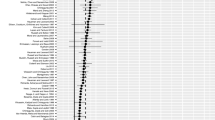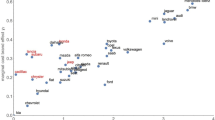Abstract
The nature of the interaction between manufacturers and retailers has received a great deal of empirical attention in the last 15 years. One major line of empirical research examines the balance of power between them and ranges from reduced form models quantifying aggregate profit and other related trends for manufacturers and retailers to structural models that test alternative forms of manufacturer-retailer pricing interaction. A second line of research addresses the sources of leverage for each party, e.g., trade promotions and their pass-through, customer information from loyalty programs, manufacturer advertising, product assortment in general, and private label assortment in particular. The purpose of this article is to synthesize what has been learnt about the nature of the interaction between manufacturers and retailers and the effectiveness of each party’s sources of leverage and to highlight gaps in our knowledge that future research should attempt to fill.

Similar content being viewed by others
References
Ailawadi, K., & Harlam, B. (2004). An empirical analysis of the determinants of retail margins: the role of store brand share. Journal of Marketing, 68(1), 147–166.
Ailawadi, K., & Harlam, B. (2009). Retailer promotion pass-through: a measure, its magnitude, and its determinants. Marketing Science, 28(4), 782–791.
Ailawadi, K., Borin, N., & Farris, P. (1995). Market power and performance: a cross-industry analysis of manufacturers and retailers. Journal of Retailing, 71(3), 211–248.
Ailawadi, K., Neslin, S., & Gedenk, K. (2001). Pursuing the value conscious consumer: store brands versus national brand promotions. Journal of Marketing, 65(1), 71–89.
Ailawadi, K., Pauwels, K., & Steenkamp, J.-B. E. M. (2008). Private label use and store loyalty. Journal of Marketing, 72(6), 19–30.
Assmus, G., Farley, J. U., & Lehmann, D. R. (1984). How advertising affects sales: meta-analysis of econometric results. Journal of Marketing Research, 21(1), 25–64.
Besanko, D., Dubé, J.-P., & Gupta, S. (2003). Competitive price discrimination strategies in a vertical channel using aggregate retail data. Management Science, 49(9), 1121–1137.
Besanko, D., Dubé, J.-P., & Gupta, S. (2005). Own-brand and cross-brand retail pass-through. Marketing Science, 24(1), 123–137.
Bolton, R., Kannan, P. K., & Bramlett, M. D. (2000). Implications of loyalty program membership and service experiences for customer retention and value. Journal of the Academy of Marketing Science, 28(1), 95–108.
Broniarczyk, S. (2008). Product assortment and consumer psychology. In: Handbook of Consumer Psychology. C. P. Haugtvedt, P. M. Herr, & F. R. Kardes (eds.), Hillsdale, NJ: Lawrence Erlbaum Associates.
Camerer, C., & Ho, T.-H. (1999). Experience-weighted attraction learning in normal form games. Econometrica, 67(4), 827–874.
Che, H., Sudhir, K., & Seetharaman, P. B. (2007). Bounded rationality in pricing under state-dependent demand: do firms look ahead? How far ahead? Journal of Marketing Research, 44(3), 434–449.
Chen, Y., Narasimhan, C., & John Zhang, Z. (2001). Individual marketing with imperfect targetability. Marketing Science, 20(1), 23–41.
Chu, J., Chintagunta, P., & Vilcassim, N. (2007). Assessing the economic value of distribution channels: an application to the personal computer industry. Journal of Marketing Research, 44(1), 29–41.
Corstjens, M., & Lal, R. (2000). Building store loyalty through store brands. Journal of Marketing Research, 37(3), 281–292.
Dhar, S. K., Hoch, S. J., & Kumar, N. (2001). Effective category management depends on the role of the category. Journal of Retailing, 77(2), 165–184.
Dorfman, R., & Steiner, P. O. (1954). Optimal advertising and optimal quality. American Economic Review, 44(5), 826–836.
Drèze, X., & Bell, D. R. (2003). Creating win-win trade promotions: theory and empirical analysis of scan-back trade deals. Marketing Science, 22(1), 16–39.
Dubé, J.-P., & Gupta, S. (2008). Cross-brand pass-through in supermarket pricing. Marketing Science, 27(3), 324–333.
Draganska, M., Klapper, D., & Villas-Boas, S. (2010). A larger slice or a larger pie: an empirical investigation of bargaining power in the distribution channel. Marketing Science, 29, 57–74.
Erdem, T., & Keane, M. P. (1996). Decision-making under uncertainty: capturing dynamic choice processes in turbulent consumer goods markets. Marketing Science, 15(1), 1–20.
Farris, P. W., & Ailawadi, K. (1992). Retail power: monster or mouse? Journal of Retailing, 68(4), 351–369.
Farris, P. W., & Reibstein, D. (1984). Overcontrol in advertising experiments. Journal of Advertising Research, 24(3), 37–42.
Gartner (2007). Consumer goods manufacturers are losing control of space management. Gartner Industry Research Report, ID G00154105, 1–4.
Geyskens, I., Gielens, K., & E.M. Gijsbrechts (2008) Proliferating private label portfolios: how introducing economy and premium private labels influences brand choice. Working Paper, CentER, Tilburg University, The Netherlands.
Goldfarb, A., Lu, Q., & Moorthy, S. (2009). Measuring brand value in an equilibrium framework. Marketing Science, 28, 69–86.
Hansen, K., & Singh, V. (2008). Are store brand buyers store loyal? An empirical investigation. Management Science, 54(10), 1828–1834.
Hartmann, W. R., & Nair, H. (2007) Retail competition and the dynamics of consumer demand for tied goods. Working Paper, Stanford University.
Hoch, S. J., & Banerji, S. (1993). When do private labels succeed? Sloan Management Review, 34(4), 57–67.
Holleran, J. (1997). Partnering with peapod. Beverage Industry, 88(10), 38–41.
Hui, S. K., Fader, P. S., & Bradlow, E. T. (2009a). Path data in marketing: an integrative framework and prospectus for model-building. Marketing Science, 28(2), 320–335.
Hui, S. K., Fader, P. S., & Bradlow, E. T. (2009b). The traveling salesman goes shopping: the systematic inefficiencies of grocery paths. Marketing Science, 28(3), 566–572.
Israelevich, G. (2004). Assessing supermarket product-line decisions: the impact of slotting fees. Quantitative Marketing and Economics, 2(2), 141–167.
Iyer, G., & Villas-Boas, M. (2003). A bargaining theory of distribution channels. Journal of Marketing Research, 40(1), 80–100.
Kadiyali, V., Vilcassim, N., & Chintagunta, P. K. (2000). Power in manufacturer-retailer interactions: an empirical investigation of pricing in a local market. Marketing Science, 19(2), 127–148.
Kaul, A., & Wittink, D. R. (1995). Empirical generalizations about the impact of advertising on price sensitivity and price. Marketing Science, 14(3), 151–160.
Kurtuluş, M., & Toktay, L. B. (2004). Category captainship: who wins, who loses? ECR Journal, 4(2), 27–33.
Lal, R., & Bell, D. (2003). The impact of frequent shopper programs in grocery retailing. Quantitative Marketing and Economics, 1(2), 179–202.
Larson, J. S., Bradlow, E. T., & Fader, P. (2005). An exploratory look at in-store supermarket shopping paths. International Journal of Research in Marketing, 22(4), 395–414.
Leenheer, J., van Heerde, H. J., Bijmolt, T. H. A., & Smidts, A. (2007). Do loyalty programs really enhance behavioral loyalty? An empirical analysis accounting for self-selecting members. International Journal of Research in Marketing, 24(1), 31–47.
Lewis, M. V. (2004). The influence of loyalty programs and short-term promotions on customer retention. Journal of Marketing Research, 41(3), 281–292.
Lodish, L. M., Abraham, M., Kalmenson, S., Livelsberger, J., Lubetkin, B., Richardson, B., et al. (1995). How TV advertising works: a meta-analysis of 389 real world split cable TV advertising experiments. Journal of Marketing Research, 32(2), 125–139.
Mantrala, M. K., Levy, M., Kahn, B. E., Fox, E. J., Gaidarev, P., Dankworth, B., et al. (2009). Why is assortment planning so difficult for retailers? A framework and research agenda. Journal of Retailing, 85(1), 71–83.
McAlister, L. (2007). Cross-brand pass-through: fact or artifact? Marketing Science, 26(6), 876–898.
Meza, S., & Sudhir, K. (2006). Pass-through timing. Quantitative Marketing and Economics, 4(3), 351–382.
Meza, S., & Sudhir, K. (2008). Do private labels increase retailer bargaining power? Working Paper, University of Toronto.
Nijs, V., Misra K., Anderson, E., Hansen, K., & Krishnamurthi, L. (2009). Channel pass-through of trade promotions. Marketing Science (in press).
Olver, J. M., & Farris, P. W. (1989). Push and pull: a one-two punch for packaged products. Sloan Management Review, 31(1), 53–61.
Pancras, J., & Sudhir, K. (2007). Optimal marketing strategies for a customer data intermediary. Journal of Marketing Research, 44(4), 560–578.
Pauwels, K. (2007). How retailer and competitor decisions drive the long-term effectiveness of manufacturer promotions for fast moving consumer goods. Journal of Retailing, 83(3), 297–308.
Pauwels, K., & Srinivasan, S. (2004). Who benefits from store brand entry? Marketing Science, 23(3), 364–390.
Rooderkerk, R. P., van Heerde, H. J., & Bijmolt, T. H. A. (2008). Collaborative retailer-manufacturer assortment optimization: an attribute-based approach. Working Paper, CentER, Tilburg University, The Netherlands.
Sethuraman, R., & Tellis, G. J. (1991). An analysis of the tradeoff between advertising and pricing. Journal of Marketing Research, 31(2), 160–174.
Shaffer, G., & Zhang, Z. J. (1995). Competitive coupon targeting. Marketing Science, 14(4), 395–416.
Sharp, B., & Sharp, A. (1997). Loyalty programs and their impact on repeat-purchase loyalty patterns. International Journal of Research in Marketing, 14(5), 473–486.
Steiner, R. L. (1973). Does advertising lower consumer prices? Journal of Marketing, 37(4), 19–26.
Sudhir, K. (2001). Structural analysis of competitive pricing in the presence of a strategic retailer. Marketing Science, 20(3), 244–264.
Sudhir, K., & Talukdar, D. (2004). Does store brand patronage improve store patronage? Review of Industrial Organization, 24(2), 143–160.
Taylor, G. A., & Neslin, S. A. (2005). The current and future sales impact of a retail frequency reward program. Journal of Retailing, 81(4), 293–305.
Trade Promotion (2005). Spending and merchandising study. Wilson, CT: Cannondale Associates.
Tyagi, R. K. (1999). A characterization of retailer response to manufacturer trade deals. Journal of Marketing Research, 36(4), 510–516.
Villas-Boas, S. B. (2007). Using retail scanner data for upstream merger analysis. Journal of Competition Law and Economics, 3(4), 689–715.
Villas-Boas, M. J., & Zhao, Y. (2005). Retailer, manufacturers, and individual consumers: modeling the supply side in the ketchup marketplace. Journal of Marketing Research, 42(1), 83–95.
Zhang, J., & Wedel, M. (2009). The effectiveness of customized promotions in online and offline stores. Journal of Marketing Research, 46(2), 190–206.
Author information
Authors and Affiliations
Corresponding author
Additional information
This paper is based on the presentations and discussion in the “Empirical Models of Manufacturer-Retailer Interaction” track at the Inaugural Erin Anderson Conference on Business-to-Business Relationships held at the Wharton School in October 2008.
Rights and permissions
About this article
Cite this article
Ailawadi, K.L., Bradlow, E.T., Draganska, M. et al. Empirical models of manufacturer-retailer interaction: A review and agenda for future research. Mark Lett 21, 273–285 (2010). https://doi.org/10.1007/s11002-010-9107-0
Published:
Issue Date:
DOI: https://doi.org/10.1007/s11002-010-9107-0




